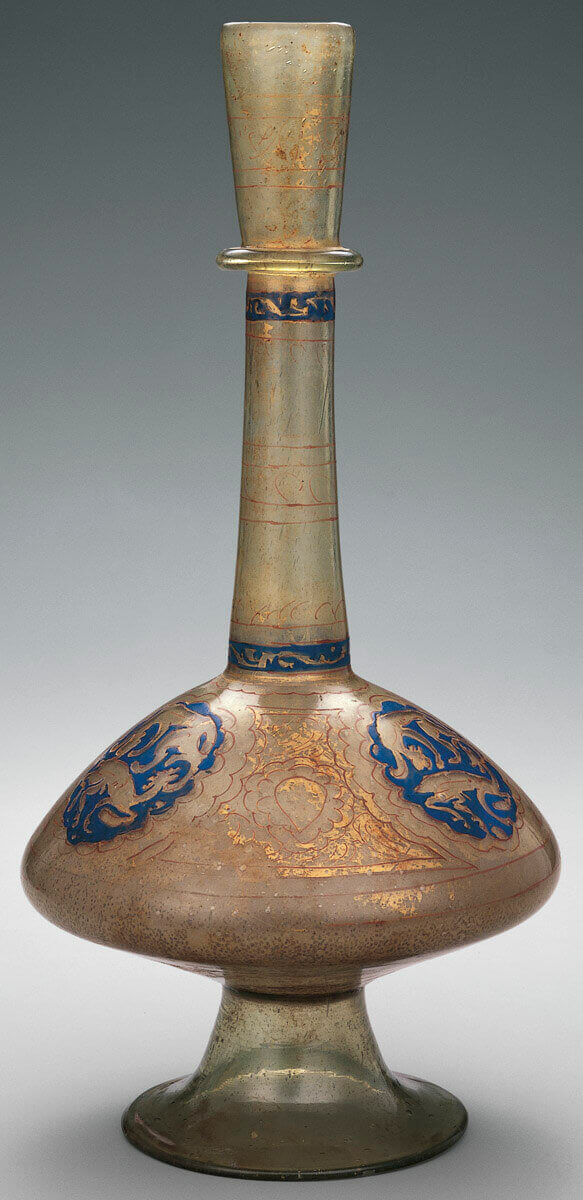
The al-Sabah Collection Overview
The story of The al-Sabah Collection starts in the 1960’s, when Nasser Sabah al-Ahmed al-Sabah was a student in Jerusalem. While in that ever-lasting city, he developed an appreciation for the superb works of craftsmen and artisans of early Islamic societies. However, not until 1975, was Nasser able to acquire an art object originating in his culture. it happened to be a mid-14th century enamelled glass vase
displayed on a shelf in Ahuan Gallery, a London art gallery owned by Oliver Hoare and David Sulzberger. It was the first item to catch his eye and fire his imagination. From this one single item a random, orderless collection grew, as did a long-term friendship with fellow collector Jassim Yousef al-Homaidhi.
Soon, what started as a private hobby, grew into a full-fledged museum! This transition took place in 1983 when the private al-Sabah Collection was moved from home to the largest building of the Kuwait National Museum compound and henceforth became to be known as Dar al-Athar al-Islamiyyah (DAI). The collection remained there until the museum was destroyed during the Iraqi invasion in August 1990.
But before that, another museum was being planned. Both Sheikh Nasser and Sheikha Hussa had reached the conclusion that the collection had too many stories to tell to be held in a private residence. In 1982, celebrated architect Hassan Fathi, known for embracing vernacular architecture, was asked to design a private museum for their collection. The couple was prepared to build a first class museum with the sole intent of providing residents of Kuwait, visitors and scholars the opportunity to explore the beauty of art from the Islamic world. Their museum would be the 1st Islamic art museum in the Gulf
About the same time, UNESCO was working with the Kuwait Government to identify the foundation objects for the new National Museum. Experts from UNESCO surveyed the three known, private collections in Kuwait: Jassim Yousef al-Homaidhi’s collection, Tareq Syed and Jehan Rajab’s collection, and Nasser al-Sabah’s collection. While all three were recognised as outstanding, containing objects that deserved to be share with a larger audience, the organisation recommended that the government approach Nasser and Hussa.
Please, click here for see UNESCO report.
The recommendation was based largely on the depth and variety of media, dynasties and geographies included in their most comprehensive collection.
Despite progress on creating a dedicated museum, the pair readily agreed to the government’s request and stopped all activities related to their private museum. To Sheikh Nasser, the loan was a continuation of his efforts to enhance the quality of life in Kuwait and promote the region’s culture – in and outside the country. A multi-faceted loan agreement was reached, with Nasser and Hussa loaning objects to the museum free of charge and the government agreeing to provide appropriate premises and qualified staff.
Please, click here for see Contract 1983.
It is interesting to note that while the couple immediately began taking the necessary steps to convert parts of their private collection to an exhibition in the time for the opening of the Kuwait National Museum in Februay 1983, the actual agreement wasn’t signed until well after the museum opened. In 2000, the contract was renewed with a slightly modified terms.
Please, click here for see Contract 2000.
A new phase of the collection evolved in the decades that followed, as Sheikh Nasser began to explore the art motifs, techniques and trends that became “Islamic art” from the late 7th century CE. Working in reverse chronology, objects from Late Antiquity (the transition period following the dawn of Islam), then Hellenistic art created outside Greece captured his attention. Ever inquisitive, he was not content to stop there. Instead he reached back even further, collecting Iron Age objects and ultimately Bronze Age objects.
Today, the collection includes more than 30,000 objects from the 4th millennium BCE through the 19th century CE. The Kuwait National Museum, destroyed during the Iraqi invasion of Kuwait, is being rehabilitated and expanded to allow greater diversity in the Dar al-Athar al-Islamiyyah galleries. In addition, objects from the collection are available to viewing at the Amricani Cultural Centre in Kuwait, the Museum of Fine Arts, Houston (MFAH), and on loans to museums and cultural institutions around the world.
Subscribe to news about Dar al-Athar al-Islamiyyah and The al-Sabah Collection, Exhibitions, Courses and Events